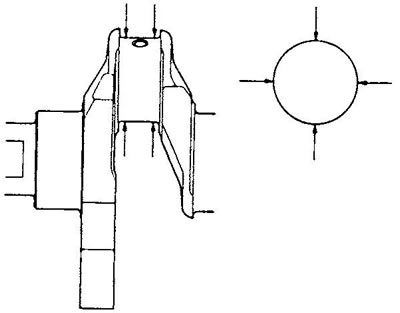Plastic gauge method
Attention:
- The crankshaft main and connecting rod bearing shells are a high precision product. The main bearing caps are machined with the block to provide the required clearance in the bearing and should not be filed in order to provide an interference fit for the bushing.
- Do not rotate the crankshaft with the plastic gauge installed in the bearing.
- The clearance in the main bearing is critical. Excessive clearance can interfere with the crankshaft position sensor signals and cause OBD II malfunctions.
- Before removing the main bearing cap, remove the cap pinch bolts.
1. Turn away bolts of fastening of a cover of the main or rod bearing, remove a cover and loose leaf.
2. Place a plastic gauge on the crankshaft journal. The length of the gauge should be equal to the width of the crankshaft journal.

3. Establish a cover of the bearing together with an insert, tighten bolts of fastening the regulated moment.
4. Remove the bearing cap and bushing.
5. Using the scale printed on the gauge envelope, determine the bearing clearance across the width of the gauge at its widest point.
- If the gauge width irregularity indicates a main bearing clearance variation greater than 0.025 mm, measure the journal.
- If the main bearing clearance cannot be adjusted to specifications, replace the crankshaft or cylinder block.

Direct measurement method
1. Measure the outer diameter of the crankshaft journal in two places along the length of the journal and in two mutually perpendicular planes. To determine the gap, take the largest diameter value.

2. Install both bearing shells, tighten the cover fastening bolts to the specified torque.
3. Measure the inner diameter of the bearing in two places along the length of the bushing and in two mutually perpendicular planes. To determine the gap, take the smallest diameter value.
4. Calculate the clearance in the bearing.

Checking the clearance in the crankpin | 
Checking the clearance in the main journal |
